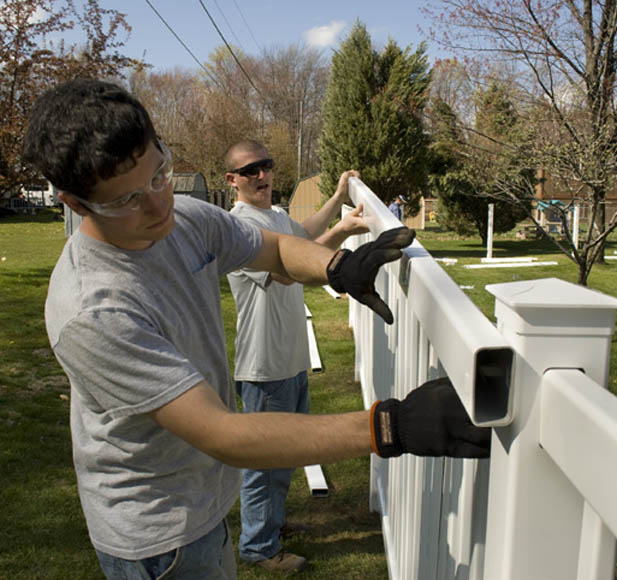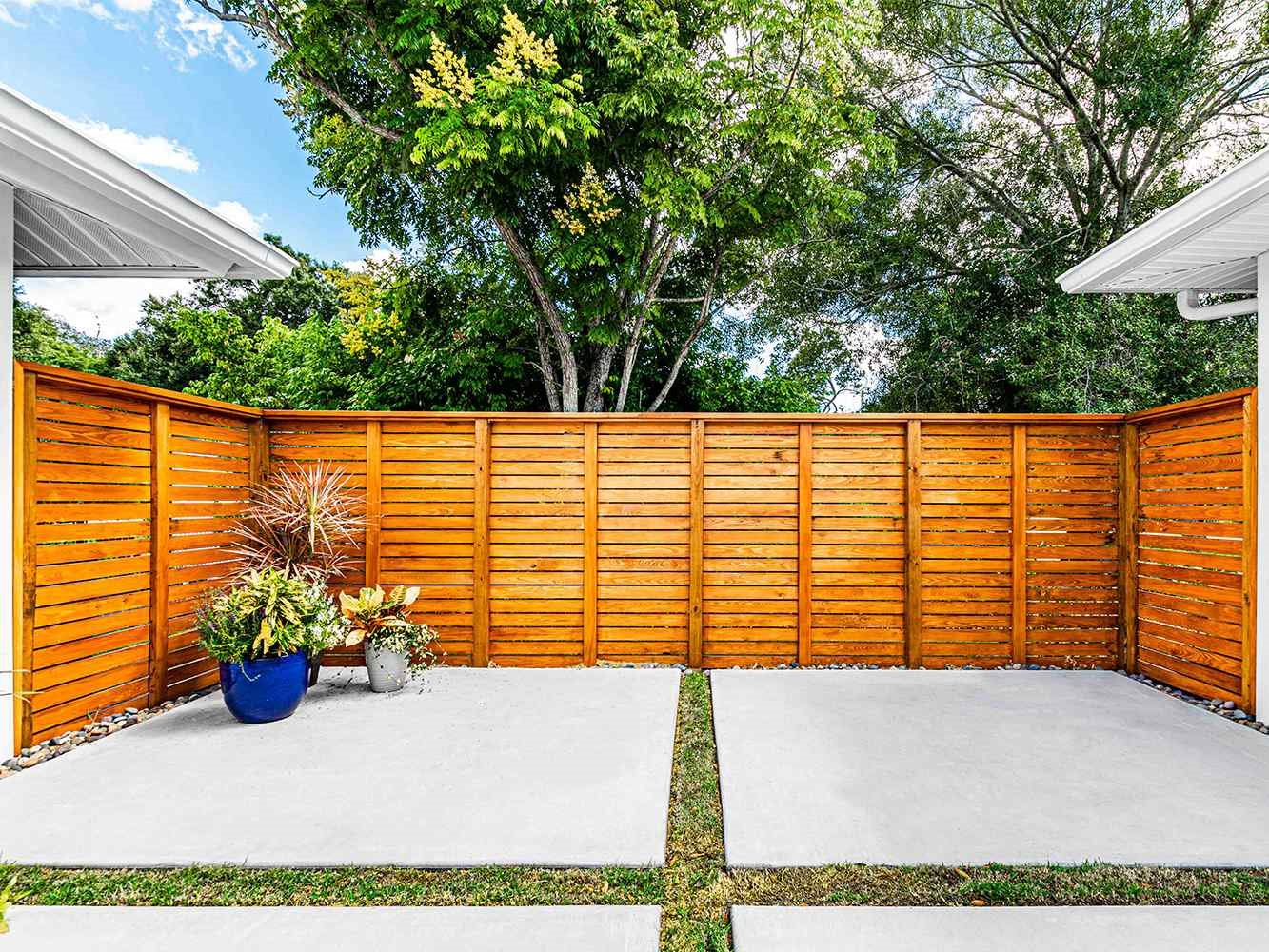Locating the Most Reputable Fence Contractor Near Me Online
Just How to Determine Common Issues That Need Immediate Fencing Repair Service
It is essential to find issues before they become bigger issues when it comes to keeping your fencing. Regularly checking for signs of rotting timber, leaning panels, or corrosion can save you money and time in the future. You might not understand just how weather condition and bugs can endanger your fencing's stability. Allow's explore the usual signs that show your fencing needs prompt focus, so you can maintain your residential property protected and looking its ideal.
Indicators of Rotting Timber in Wooden Fences
Have you observed your wood fencing looking a bit shabby? If so, it could be time to look for signs of rotting wood. First, examine the base of the messages and panels for soft areas. If you continue the timber and it really feels spongy or falls apart, that's a clear indication of rot. Next off, try to find staining or dark areas on the timber-- these typically signal wetness damages. Focus on any type of peeling off paint or surface, as this can reveal the wood to further degeneration. In addition, a poignant, musty scent can suggest fungal development. Do not neglect to inspect joints and links; if they hang or crumbling, the timber under is most likely jeopardized. By capturing these signs early, you can prevent extra comprehensive damages and maintain your fencing standing strong. Routine maintenance is vital to prolonging the life of your wood fence.
Leaning or Tilting Fence Panels
It's crucial to recognize what created it if you've seen your fencing panels tilting or leaning. This concern could show underlying structural damage that needs your focus. Allow's explore the common reasons and the repair work alternatives readily available to get your fencing back in form.

Causes of Leaning Panels
When you observe your fencing panels leaning or turning, it's often an indication of underlying issues that need addressing. One usual reason is poor drainage; excessive water can deteriorate the soil around the fencing posts, weakening their assistance. One more culprit could be strong winds or tornados that press against the panels, especially if they're not correctly secured. Additionally, the all-natural settling of dirt in time can cause posts to move, leading to a tilt. Insects, like termites, can compromise the integrity of wood panels, triggering them to lean too. Lastly, bad installment methods might lead to panels not being safely set, leaving them prone to leaning under stress. Address these concerns quickly to keep your fence's stability.
Indicators of Structural Damage
Observing tilting or leaning fence panels can be disconcerting, as these concerns frequently indicate architectural damages that needs instant attention. When your fencing begins to lean, it may indicate that the posts are shifting or that the dirt around them has eroded. Pay close attention to gaps between panels or articles, as these can also recommend instability. deck builder. In addition, check for fractures or splintering in the wood, which can weaken the general framework. If you discover rust or corrosion on steel elements, it can compromise the honesty of the fencing. Keep in mind, disregarding these indicators can cause more extreme damage down the line, so it's vital to assess the scenario immediately and do something about it before it intensifies
Repair Options Available

Corrosion and Rust in Metal Fences
If you possess a metal fence, you may observe rust and deterioration slipping in in time, especially if it's revealed to wetness. These problems not only affect the look of your fence yet can also jeopardize its architectural integrity. To recognize corrosion, try to find reddish-brown places or spots, which suggest the steel is oxidizing. Deterioration can spread swiftly if left unattended, compromising the fencing and leading to costly repairs.To deal with corrosion and rust, you should clean up the influenced locations with a cord brush and use a rust-inhibiting guide. When the primer dries, consider painting the fencing with a weather-resistant paint to secure it additionally. Routine maintenance, such as examining for signs of rust and repairing paint as required, will certainly assist extend your fencing's lifespan. Resolving these problems promptly ensures your steel fence continues to be solid and visually appealing for several years ahead.
Fractures and Divides in Vinyl Secure Fencing

Reasons For Vinyl Damage
Vinyl fence is popular for its sturdiness, yet it can still experience from splits and splits because of numerous aspects. One significant cause is severe temperature level variations. It can deteriorate the product over time when vinyl increases in the warm and contracts in the cool. Furthermore, exposure to extreme sunshine can result in UV degradation, making the plastic breakable. Physical impacts, like accidental collisions or heavy branches, can additionally create fractures. Poor installment or using low-grade products can exacerbate these problems. Furthermore, age contributes; older plastic fencing is extra prone to damages. Routine assessments can assist you determine these aspects prior to they result in considerable issues. Take aggressive steps to assure your fencing continues to be solid and intact.
Fixing Cracks Effectively
Although fractures and divides in your plastic secure fencing can be worrying, addressing them promptly can avoid additional damage and preserve the fence's appearance. First, evaluate the like it size of the fracture. For tiny splits, a plastic repair service set often consists of glue that can bond the sides, giving a smooth fix. Clean the area completely prior to applying the glue, ensuring it sticks correctly. For bigger divides, you could need to make use of a vinyl spot. Cut the patch to size, apply sticky around the sides, and press it securely onto the split. Enable it to cure as per the producer's directions. Routine maintenance and quick repairs can prolong your fencing's life expectancy, keeping it looking fantastic for several years to find.
Loose or Missing Out On Fence Articles
Loose or absent fencing messages can undermine the stability of your entire fencing structure. It's necessary to address the problem immediately if you observe any messages wobbling or leaning. Look for any indications of movement, as this can bring about further damage gradually. You can conveniently evaluate the issue by offering each post a gentle shake-- if it really feels unpredictable, it's time to take action.For missing messages, you'll require to replace them as soon as possible to preserve your fencing's honesty. When you set up new articles, make sure they're safely anchored in the ground with concrete or crushed rock for added stability. If a message is loose, tighten it by including extra assistance or driving it deeper into the ground.Ignoring these problems can bring about larger problems, like voids in your fence or perhaps complete collapse. Maintain an eye on your messages and stay aggressive concerning fixings!
Damages From Climate and Natural Environment
Climate and natural environments can ruin your fence, leading to various kinds of damages that require prompt attention. Hefty rain can trigger timber to rot, making it weak and unpredictable. Snow accumulation could bend or damage panels, while strong winds can uproot fencing blog posts or trigger sections to lean.If you notice splits or splintering in wooden fences, it suggests drying due to extreme sunlight exposure. At the same time, metal fences can corrosion if protective finishes subside, especially in coastal or damp areas.Inspect your fence frequently after tornados or severe weather condition to capture any type of damages early. Dealing with these concerns swiftly can save you from costly fixings down the line. Don't wait up until a tiny issue becomes a major one; stay aggressive and keep your fence top shape to keep both performance and visual charm.
Parasite Infestation and Termite Damages
When you discover indicators of pest invasion or termite damage, it's important to act promptly to stop further devastation. Try to find mud tubes along your fencing or hollow-sounding wood, as these show termites go to job. You could additionally see tiny holes or frass, which is termite droppings appearing like sawdust. If you spot any one of these signs, it's time to analyze the damage.Don' t wait till it's far too late; parasites can jeopardize your fencing's stability. Evaluate the surrounding area for ants or beetles, as they might be adding to the issue. If you believe an invasion, think about getting in touch with an insect control expert to verify and deal with the issue.Repairing or changing damaged areas of your fence promptly not just restores its strength yet also stops pests from spreading better. Remain watchful to maintain your residential property pest-free and secure.
Regularly Asked Questions
Just how Usually Should I Inspect My Fence for Damage?
You need to examine your fence a minimum of twice a year, ideally throughout spring and autumn. Routine checks assist you detect damage early, conserving you time and money on repairs while maintaining your residential or commercial property's appearance and safety and security.
Can I Repair a Fencing Myself or Employ a Specialist?
You can definitely repair a fencing on your own if you have the right tools and abilities. Hiring an expert warranties high quality work and saves you time, particularly for complex repair services or considerable damage.
What Tools Are Required for Basic Fencing Repair Services?
For fundamental fencing fixings, you'll need tools like a hammer, screwdriver, pliers, a saw, a degree, and determining tape. deck builder. Depending on the content repair, you might also require nails, screws, or replacement boards
Just How Much Does Fence Repair Usually Expense?
Fence fixing costs differ widely, yet you can anticipate to pay in between $200 and $1,500 relying on materials, labor, and level of damage. It's wise Recommended Reading to obtain multiple quotes for the ideal deal.
When Is the most effective Time of Year for Fencing Repair Works?
The best time for fencing repair work is throughout light climate, typically in spring or very early autumn. You'll avoid severe temperatures, making it less complicated to function and ensuring the products set appropriately for lasting resilience (deck builder). Discovering leaning or turning fencing panels can be startling, as these problems often indicate structural damages that requires prompt attention. Loose or absent fence articles can weaken the stability of your whole fencing framework. Snow build-up could bend or break panels, while solid winds can root out fencing articles or cause areas to lean.If you notice cracks or splintering in wooden fencings, it's a sign of drying out due to intense sunlight exposure. Steel fences can rust if protective coverings use off, specifically in seaside or moist areas.Inspect your fence on a regular basis after tornados or extreme weather condition to capture any type of damages early. Fence repair prices differ widely, yet you can anticipate to pay between $200 and $1,500 depending on materials, labor, and level of damage